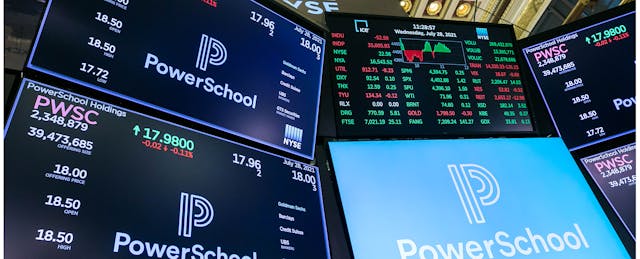Companies like to talk about their journey in raising money and growing over time, and one waypost for such journeys is to reach the ringing bells of a stock-market debut. PowerSchool Holdings, Inc. heard those bells today, as the company began trading on the New York Stock Exchange—though the initial price ended up on the low end of expectations.
It looks like the company, which offers student information systems for schools, will raise about $711 million, with shares priced at $18 each (some thought the price could be as much as $20). Much of that money will apparently go toward paying off debt and covering fees related to going public, though officials say they are also putting $1 million in a donation to “philanthropic initiatives to benefit K-12 educators.”
Shares did rise nearly 3 percent in early trading, giving the software provider a valuation of about $3.6 billion.
PowerSchool’s journey has gone like this: It was founded in 1997, back in the early days of the web and before smartphones, tablets or social media even existed. Tech giant Apple bought the company in 2001. Then publishing giant Pearson bought it from Apple in 2006. But by 2015, Pearson was looking to unload PowerSchool, which was bought by the private-equity firm Vista Equity Partners for $350 million.
Under Vista’s ownership, PowerSchool has spent more than $1 billion acquiring other edtech companies, including grabbing the Schoology learning management system popular with K-12 schools.
What now?
The other day, EdSurge checked in with PowerSchool’s chief product officer Marcy Daniel to ask just that.
She called the pandemic a “seminal moment” for edtech. “What the pandemic showed us—and showed districts—is you need core tech,” she said.
PowerSchool, like so many edtech companies, saw boosts in usage as schools were forced online by health concerns related to COVID-19. One question, though, is whether schools will continue to make as much use of all this tech as in-person teaching resumes.
Naturally, the company is arguing that usage will grow.
“What we’re hearing from districts, and what we’re seeing in our business, is the digital transformation is here to stay,” Daniel said. And she added that remote learning is only one piece of what their services aid.
“As districts move back into classrooms, we are very focused on the fall and helping districts support the learning loss that occurred,” she added. One way the company hopes to do that, she said, is through greater use of data, or what she called “data-driven infrastructure.”
According to recent filings, PowerSchool had a net loss of $2 million for the three months that ended March 31, with revenue of $118 million.
PowerSchool is one of a string of edtech IPOs this year. Just today, language-learning app maker Duolingo went public on NASDAQ. Last week Instructure, which makes the Canvas learning management system, went public, and Coursera had its IPO in March.


